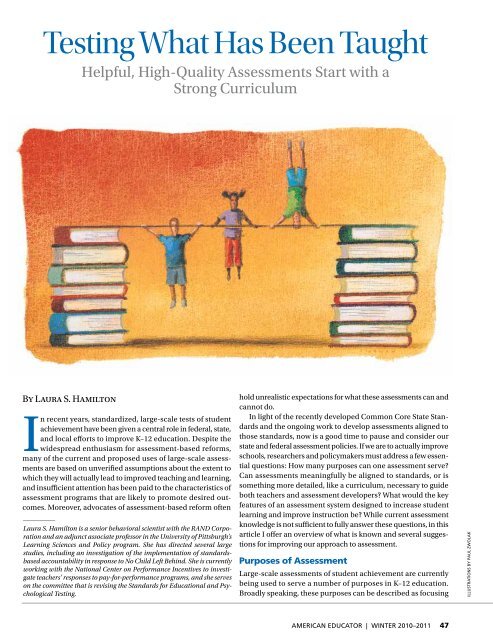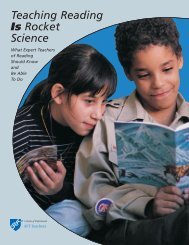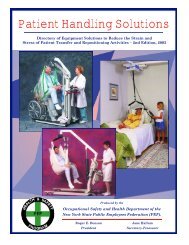American Educator, Winter 2010-11, Vol. 34, No. 4, AFT
American Educator, Winter 2010-11, Vol. 34, No. 4, AFT
American Educator, Winter 2010-11, Vol. 34, No. 4, AFT
Create successful ePaper yourself
Turn your PDF publications into a flip-book with our unique Google optimized e-Paper software.
Testing What Has Been Taught<br />
Helpful, High-Quality Assessments Start with a<br />
Strong Curriculum<br />
By Laura S. Hamilton<br />
In recent years, standardized, large-scale tests of student<br />
achievement have been given a central role in federal, state,<br />
and local efforts to improve K–12 education. Despite the<br />
widespread enthusiasm for assessment-based reforms,<br />
many of the current and proposed uses of large-scale assessments<br />
are based on unverified assumptions about the extent to<br />
which they will actually lead to improved teaching and learning,<br />
and insufficient attention has been paid to the characteristics of<br />
assessment programs that are likely to promote desired outcomes.<br />
Moreover, advocates of assessment-based reform often<br />
Laura S. Hamilton is a senior behavioral scientist with the RAND Corporation<br />
and an adjunct associate professor in the University of Pittsburgh’s<br />
Learning Sciences and Policy program. She has directed several large<br />
studies, including an investigation of the implementation of standardsbased<br />
accountability in response to <strong>No</strong> Child Left Behind. She is currently<br />
working with the National Center on Performance Incentives to investigate<br />
teachers’ responses to pay-for-performance programs, and she serves<br />
on the committee that is revising the Standards for Educational and Psy-<br />
hold unrealistic expectations for what these assessments can and<br />
cannot do.<br />
In light of the recently developed Common Core State Standards<br />
and the ongoing work to develop assessments aligned to<br />
those standards, now is a good time to pause and consider our<br />
state and federal assessment policies. If we are to actually improve<br />
schools, researchers and policymakers must address a few essential<br />
questions: How many purposes can one assessment serve?<br />
Can assessments meaningfully be aligned to standards, or is<br />
something more detailed, like a curriculum, necessary to guide<br />
both teachers and assessment developers? What would the key<br />
features of an assessment system designed to increase student<br />
learning and improve instruction be? While current assessment<br />
knowledge is not sufficient to fully answer these questions, in this<br />
article I offer an overview of what is known and several suggestions<br />
for improving our approach to assessment.<br />
ZWOLAK<br />
Purposes of Assessment<br />
PAUL BY<br />
Large-scale assessments of student achievement are currently<br />
being used to serve a number of purposes in K–12 education.<br />
chological Testing. Broadly speaking, these purposes can be described as focusing<br />
ILLUSTRATIONS<br />
AMERICAN EDUCATOR | WINTER <strong>2010</strong>–20<strong>11</strong> 47





